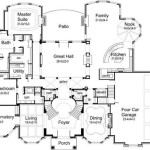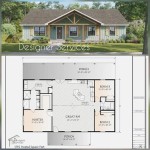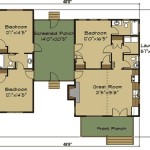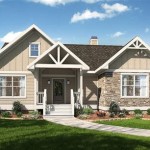Narrow Lot House Plans With Detached Garage: Optimizing Space and Functionality
Narrow lot house plans present unique design challenges and opportunities. Architects and homeowners must creatively maximize limited square footage while maintaining a comfortable and functional living space. One increasingly popular solution for narrow lots is the incorporation of a detached garage. This approach allows for greater design flexibility, improved street appeal, and the potential for additional storage or living space above the garage itself. Careful planning and consideration of local zoning regulations are critical when exploring narrow lot house plans with a detached garage.
The advantages of a detached garage extend beyond simply freeing up space on the main house footprint. A detached structure can contribute to a more private backyard, reduce noise transmission into the living areas, and provide a distinct architectural element that enhances the property's overall aesthetic. However, there are also potential drawbacks, such as requiring additional walking distance between the house and the garage, particularly in inclement weather, and the added cost of constructing a separate building with its own foundation, utilities, and roof. This article will delve into the various considerations involved in designing and implementing narrow lot house plans with detached garages, highlighting key design principles, practical considerations, and potential benefits.
Maximizing Space and Minimizing Footprint
The primary objective when designing a narrow lot house plan is to optimize the available space. This requires a strategic approach to layout, room sizes, and overall building orientation. The detached garage plays a crucial role in this optimization process. By separating the garage from the main house, architects can create a more streamlined and efficient floor plan for the residence itself.
One common strategy is to position the detached garage at the rear of the property, accessed via a driveway along one side of the house. This configuration allows for a larger backyard area, which can be particularly valuable on narrow lots where outdoor space is limited. Alternatively, the garage can be placed to the side of the house, creating a courtyard effect and providing a buffer between the house and neighboring properties.
Within the house itself, space-saving techniques such as open-plan living areas, built-in storage solutions, and strategically placed windows can significantly enhance the feeling of spaciousness. Utilizing vertical space through the inclusion of multiple stories or a finished basement can also expand the usable living area without increasing the footprint of the house.
The design of the detached garage itself is also critical. Consider the specific needs of the homeowners, such as the number of vehicles to be accommodated, storage requirements, and potential for future use as a workshop or studio. The garage's dimensions should be carefully planned to maximize functionality without encroaching excessively on the available yard space. For instance, a single-car garage may be sufficient for a single individual or couple, while a two-car garage may be necessary for a family with multiple vehicles.
Furthermore, the aesthetic design of the garage should complement the overall architectural style of the house. Using similar materials, colors, and detailing can create a cohesive and visually appealing property. Consider incorporating architectural features such as a pitched roof, decorative windows, or a pergola to enhance the garage's aesthetic appeal and integrate it seamlessly with the main house.
Addressing Zoning Regulations and Site Constraints
Before embarking on any construction project, it is essential to thoroughly research and understand the local zoning regulations. These regulations dictate various aspects of building design and construction, including setbacks, height restrictions, lot coverage limits, and parking requirements. Failure to comply with zoning regulations can result in costly delays, fines, or even the rejection of building permits.
Zoning regulations often specify minimum distances between buildings and property lines, known as setbacks. These setbacks are designed to ensure adequate spacing between structures, maintain privacy for neighboring properties, and provide access for emergency vehicles. The placement of a detached garage must comply with these setback requirements, which may vary depending on the location of the garage (front, side, or rear of the property).
Lot coverage limits restrict the percentage of the property that can be covered by buildings and impervious surfaces, such as driveways and patios. Designing a narrow lot house plan with a detached garage requires careful consideration of these limits to ensure that the total footprint of the house and garage does not exceed the allowable coverage.
Parking requirements may also dictate the number of parking spaces that must be provided on the property. A detached garage typically counts towards these parking requirements, but it is essential to confirm this with the local zoning authorities. In some cases, additional parking spaces may be required in the driveway or on the street, depending on the size and occupancy of the house.
Beyond zoning regulations, site constraints such as topography, soil conditions, and existing utilities can also impact the design and construction of a narrow lot house with a detached garage. Steep slopes may require additional grading or retaining walls, while unstable soil may necessitate specialized foundation design. The location of existing utility lines must also be carefully considered to avoid conflicts during excavation and construction.
A professional surveyor can provide accurate information about property boundaries, topography, and utility locations. Consulting with a qualified architect or engineer can also help to identify and address potential site constraints before the design process begins. This proactive approach can save time and money by preventing costly surprises during construction.
Exploring Design Options and Functionality
Narrow lot house plans with detached garages offer a wide range of design options and functionalities. The detached garage can serve not only as a parking space but also as a versatile space for storage, hobbies, or even additional living quarters. The design of the garage should be tailored to the specific needs and preferences of the homeowners.
One popular option is to incorporate a loft or second story above the garage. This space can be used as a guest suite, home office, studio, or recreational room. Adding a separate entrance to the loft allows for privacy and independence from the main house. Consider including a kitchenette and bathroom to create a self-contained living space.
The garage can also be designed as a workshop or hobby space. Incorporating ample lighting, electrical outlets, and storage solutions can create a functional and comfortable workspace. Consider adding a workbench, tool storage cabinets, and a ventilation system to accommodate various hobbies and projects.
Another option is to integrate the detached garage with the backyard landscape. Creating a seamless transition between the garage and the outdoor living area can enhance the overall aesthetic appeal of the property. Consider adding a pergola, patio, or garden to create a welcoming and inviting space.
The material selection for the detached garage should complement the architectural style of the house. Using similar siding, roofing, and trim details can create a cohesive and visually appealing property. Consider using durable and low-maintenance materials to minimize upkeep and ensure long-term performance.
Finally, consider the accessibility of the detached garage. Ensure that the driveway is wide enough to accommodate vehicles and pedestrians. Install adequate lighting to provide safety and security. Consider adding a covered walkway between the house and the garage to provide protection from the elements.
In conclusion, designing a narrow lot house plan with a detached garage requires careful planning and consideration of various factors, including space optimization, zoning regulations, site constraints, and design options. By addressing these considerations thoughtfully, homeowners can create a functional, aesthetically pleasing, and valuable addition to their property.

Narrow Lot Traditional With Alley Garages

House Plan 3 Bedrooms 2 5 Bathrooms Garage 3877 V1 Drummond Plans

20 Luxury Narrow House Plans With Front Garage Images Small Traditional Plan

All Narrow Lot House Plans And Designs Full Hd Pics

Garage Dilemma Narrow Lot

Rear Lane Access Home Designs G J Gardner Homes

Cozy Cottage With A 2 Car Detached Garage For Narrow Lot 39297st Architectural Designs House Plans

Narrow Lot House Plans With Attached Garage Under 40 Feet Wide

The Arcadia Suits 12m Lot Rear Garage Perth Builder Switch Homes Narrow House Plans Cottage Floor

Narrow Lot Vacation Home Plan 18762ck Architectural Designs House Plans








